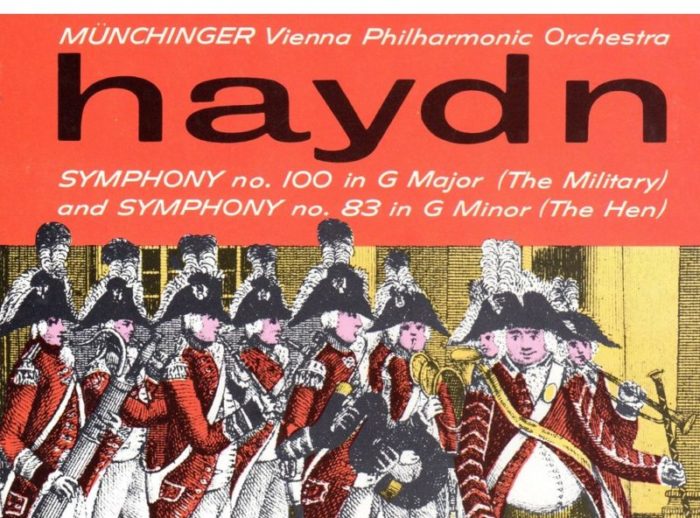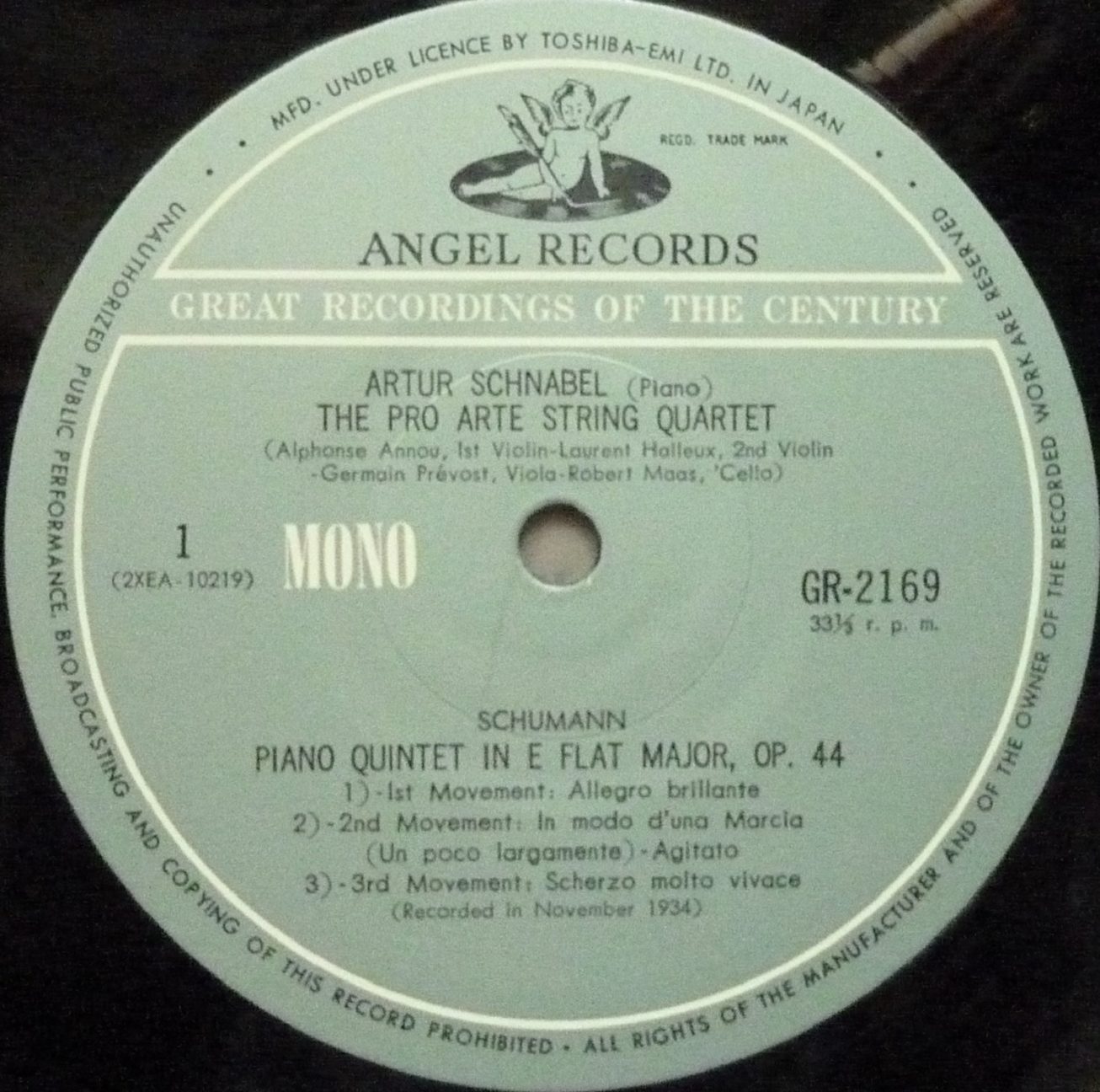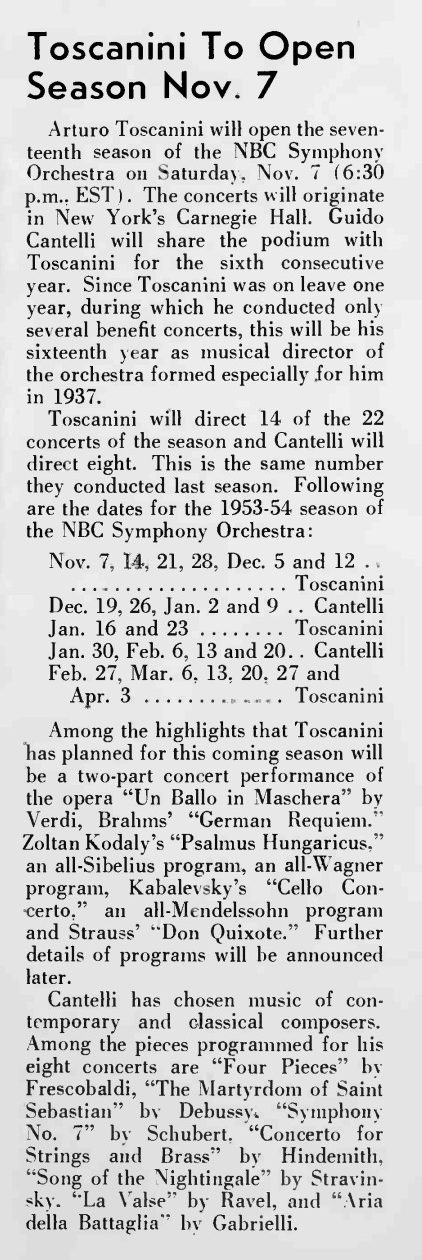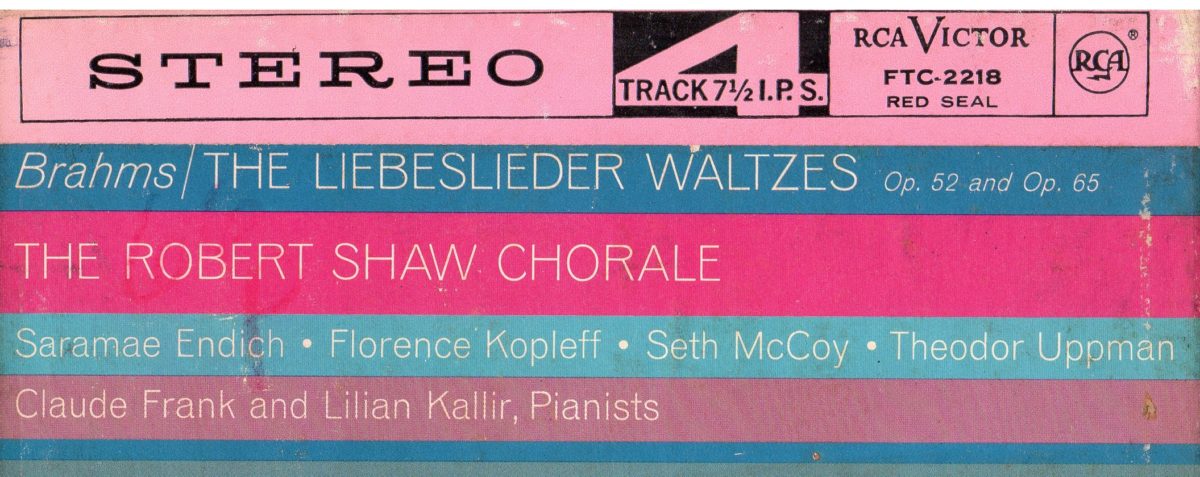
Le label Maestro Editions de Richard Chlupaty propose sous forme d’un album de 2 CD (ME 221) l’enregistrement intégral du concert Mozart donné le 12 juin 1953 au Palais des Fêtes de Strasbourg par Edwin Fischer et l’Orchestre Municipal de Strasbourg, au cours du Festival de Strasbourg 1953.
Pour plus d’information, lire l’article en cliquant sur le lien:
Richard Chlupaty’s label Maestro Editions has just published a 2 CD album (ME 221) comprised of the complete recording of the Mozart concert given on 12 June 1953 at the Strasbourg ‘Palais des Fêtes’ by Edwin Fischer and the ’Orchestre Municipal de Strasbourg’, as part of the ‘Festival de Strasbourg 1953’.
To know more about this issue, please click on this link:

Karl Münchinger Wiener Philharmoniker (WPO)
Wien Sofiensaal: 10-12 avril 1961
Prod: Christopher Raeburn – Eng: James Brown
Source Bande/Tape LCL 80093 (4 pistes 19 cm/s / 4 tracks 7.5 ips)
Voici deux autres symphonies de Haydn parmi les plus connues, que nous offrent les Wiener Philharmoniker à leur sommet sous la baguette de Münchinger, toujours pertinent dans ce répertoire.

Here are two further most celebrated Haydn symphonies, performed by the Wiener Philharmoniker in top form, under the direction of Karl Münchinger, always relevant in this repertoire.

Artur Schnabel, piano
Quintette Op.44 Quatuor Pro Arte
Abbey Road Studio n°3 – 19 November 1934
Source: 33t/LP Toshiba-EMI Angel Japan GR-2169
Concerto Op.54 Alfred Wallenstein Los Angeles Philharmonic Orchestra (LAPO)
Glendale (CA) – Hoover High School 4 March 1945
Source: 33t./LP Bruno Walter Society BWS-724 – annonce/announcement: fichier mp3/mp3 file (Internet)
Artur Schnabel a peu enregistré Schumann pour le disque, uniquement ce Quintette et les Kinderszenen. On a deux enregistrements publics du Concerto pour piano, l’un avec le NYPO et Pierre Monteux, et l’autre avec le LAPO et Alfred Wallenstein. Au programme de ses récitals, on trouve rarement des œuvres de Schumann (Davidsbündlertänze Op.6 et Fantaisie Op.17).
En 1975, lorsque BWS a publié en microsillon l’enregistrement du Concerto avec Alfred Wallenstein, Karl-Ulrich, le fils du pianiste, l’a écarté comme étant un faux. Pourtant, l’enregistrement du concert complet existe avec les annonces radio (il est disponible en mp3 sur Internet), et Schnabel en relate les conditions très particulières dans une lettre datée du 5 mars 1945 à son amie et confidente Mary Virginia Foreman:
‘ Hier soir, c’était le premier concert à Glendale. C’était la ‘Standard Oil West Coast hour’. Ils m’ont trompé en ne me le disant pas, et j’ai joué pour le même cachet que pour les autres concerts, où personne sauf les gens présents dans la salle peuvent entendre l’exécution. Je suis heureusement assez vieux pour ne pas faire d’histoires ou me mettre en colère. Le concert – si on peut le dénommer ainsi – n’avait aucun sens. Répétition à 16h30. J’ai donc joué le Schumann trois fois en l’espace de quatre heures. La ‘Standard Hour’ se doit de bourrer soixante minutes avec de la musique. Elle l’a fait avec: Ouverture d’Hansel and Gretel, Air du Concours de Wagner (sans chanteur), le Concerto de Schumann, et l’Apprenti de Dukas – et quelques mots pour les retardataires. La salle, une grange hyper-résonnante.’
Si le jeu de Schnabel est ici inhabituel au point d’avoir dérouté son propre fils, ceci semble dû au peu de temps de répétition qui a empêché une coordination entre les deux musiciens et à la direction un peu rude et peu différenciée de Wallenstein, qui a cependant l’avantage d’imprimer une tension permanente (ou si on veut, une ’fièvre schumanienne’) au discours musical, qui semble manquer parfois à la version plus orthodoxe avec Pierre Monteux*. Autrement dit, Schnabel est ici sous pression.
L’enregistrement du Quintette Op.44 possède toute la tension nécessaire, mais Schnabel joue avec ses partenaires habituels du Quatuor Pro Arte.
* Concert donné une seule fois à Carnegie Hall avec le NYPO le 13 juin 1943 (au lieu du 27 juin), avec une seule répétition le 12, donc des conditions à peine meilleures qu’en Californie 2 ans plus tard.


Artur Schnabel has made only two commercial recordings of the music by Schumann, only this Piano Quintet and the Kinderszenen. We have two live recordings of the Piano Concerto, one with the NYPO and Pierre Monteux, and one with the LAPO and Alfred Wallenstein. In his recitals, he rarely performed works by Schumann (Davidsbündlertänze Op.6 et Fantaisie Op.17).
In 1975, when BWS isued the LP with the recording of the Concerto with Alfred Wallenstein, the pianist’s son Karl-Ulrich dismissed it as a counterfeit. However, a complete recording of the concert exists with the radio announcements (it is available as a mp3 on the Internet), and Schnabel describes the very peculiar conditions in a letter dated Mars 5, 1945 to his friend and confidante Mary Virginia Foreman:
‘ Last night was the first concert in Glendale. It was the Standard Oil West Coast hour. They cheated me by not telling me this, and I played for the same fee as for the other concerts, when nobody except the people in the hall can hear the performance. I am, fortunately, now old enough not to get fussy or angry. The concert – if one could call it that – was just barbarous. Rehearsal at 4.30pm. I accordingly played tne Schumann three times within four hours. The Standard Hour has to stuff sixty minutes with music. It did with: Hansel and Gretel Overture, Prize Song by Wagner (no singer), Schumann Concerto, Dukas’ Apprentice – and words for latecomers. The place, an over-resonant barn.’
If Schnabel’s playing is here unusual to the point of having puzzled his own son, it seems to be due to the lack of rehearsal time which did not allow a coordination between the two musicians and to the rather hard and undifferenciated rendering of the score by Wallenstein, which however has the advantage of bringing a permanent tension (or ‘Schumann fever’ if you will) to the musical discourse, which seems to be lacking at times in the more conventional performance with Pierre Monteux*. In other words, Schnabel plays under pressure.
The recording of the Quintette Op.44 has all the required tension, but Schnabel plays with his longtime partners of the Quatuor Pro Arte.
* Concert given only once at Carnegie Hall with the NYPO on June 13, 1943 (instead of June 27), with a single rehearsal on June 12, thus hardly better conditions than in California 2 years later.

Arturo Toscanini – NBC Symphony Orchestra
Beethoven Symphony n°6 Op.68
Carnegie Hall – March 7, 1954 Source: Bande / Tape 19 cm/s / 7.5 ips
Les deux dernières saisons (1952-1953 et 1953-1954) de Toscanini à la tête du NBC SO ont apporté deux modifications significatives.
Tout d’abord, le remplacement de Mischa Mischakoff par Daniel Guilet, membre de l’orchestre depuis 1944, en tant que Concertmaster a ouvert de nouvelles perspectives. Guilet était un musicien d’envergure, spécialiste de musique de chambre (Quatuor Calvet, Guilet Quartet) et il sera d’ailleurs peu après (en 1955) un des fondateurs du Beaux Arts Trio.
La deuxième modification était l’amélioration des techniques d’enregistrement chez RCA, avec le recours à moins de microphones (début 1953, la 9ème de Dvorak, la 9ème de Schubert et les Tableaux d’une Exposition de Moussorgski ont été enregistrés à Carnegie Hall avec un seul microphone). Les deux derniers concerts, le 21 mars et le 4 avril 1954, ont même été captés en stéréo expérimentale.
Début octobre 1953, le programme de la saison à venir a été annoncé et Toscanini a fait savoir depuis l’Italie que ce sera pour lui la dernière:

___________________

NBC Chimes – October 1953
Très vite, RCA a adapté sa stratégie et le programme publié a été complètement revu pour utiliser uniquement les prises de son réalisées lors des répétitions et des concerts pour produire des enregistrements commerciaux qui manquaient à sa discographie, et ce d’autant plus que Toscanini, on le sait, n’a pas pu diriger les deux premiers programmes (8 et 15 novembre) pour lesquels il a été remplacé par Pierre Monteux, et que pour celui du 28 mars, il a invité Charles Munch à le remplacer. Les concerts annoncés initialement pour le samedi à 18h30 ont été reprogrammés le dimanche à la même heure, juste après la retransmission (14h30) du concert dominical du New York Philharmonic.

Programme initial du concert du 8 Novembre / Initial Program of the November 8 concert
Il a donc dirigé 11 concerts dont 8 ont servi en tout ou partie pour des enregistrements commerciaux (dans la liste ci-dessous, les œuvres ayant fait l’objet à cette occasion d’un enregistrement commercial sont soulignées). Si on met à part les deux derniers concerts qui sont notoirement très inférieurs au reste de la saison, il reste un joyau inédit, c’est la ‘Pastorale’ du 7 mars 1954, une grand réussite, fort bien captée, dans laquelle Toscanini se montre étonnamment détendu, voir euphorique, ou plus précisément ‘heiter’ comme Beethoven le préconise pour le premier mouvement.
Ce jour là, Cantelli dirigeait le NYPO et les deux chefs se sont retrouvés en concurrence radiophonique!
___________________
22 Nov. 1953: Brahms: Tragic Overture Op.81; Strauss: Don Quixote (Frank Miller, cello – Carlton Cooley, viola)
29 Nov. 1953: Wagner: Tannhäuser Prelude Act III; Berlioz: Harold en Italie Op.16 (Carlton Cooley, viola)
6 Dec. 1953: Beethoven ; Coriolan Ouv.; Symphony n°3 Op.55
13 Dec. 1953: Moussorgsky: Khovantschina Prelude; Franck: les Eolides; Weber: Invitation à la Valse Op.65; Mendelssohn: Symphony n°5 Op.107 ‘Reformation’
17 & 24 Jan. 1954: Verdi: Un Ballo in Maschera (Pierce, Merrill, Nelli, Turner, Haskins, Moscona, Scott)
28 Feb. 1954: Mendelssohn: Symphony n°4 Op.90; Strauss: Don Juan Op.20; Weber: Oberon Ouv.
7 Mar. 1954: Beethoven: Leonore II Op.72b; Symphony n°6 Op.68
14 Mar. 1954: Vivaldi: Concerto grosso Op.3 n°11; Verdi: Te Deum; Boïto: Mefistofele Prologue Robert Shaw Chorale – Nicola Moscona The Columbus Boychoir (Boïto)
21 Mar. 1954: Rossini: Il Barbiere di Siviglia Ouv.; Tchaïkovsky: Symphony n¨6 Op. 74
4 Apr. 1954: Wagner Lohengrin: Prelude; Siegfried: Waldbeben; Götterdämmerung: Dämmerrung und Siegfrieds Rheinfahrt; Tannhäuser: Ouverture & Bacchanale; Meistersinger: Prelude
____________________
Toscanini’s last two seasons (1952-1953 and 1953-1954) as Music Director of the NBC SO have brought two main changes.
Firstly, the replacement of Mischa Mischakoff by Daniel Guilet, member of the orchestra since 1944, as Concertmaster has opened up new perspectives. Guilet was a great musician, and his speciality was chamber music (Quatuor Calvet, Guilet Quartet) and he was soon to be (in 1955) one of the founding members of the Beaux Arts Trio.
The second change was an improvement in RCA recording techniques, with less microphones (at the beginning of 1953, Dvorak’s 9th, Schubert’s 9th and Mussorgsky’s Pictures at an Exhibition were recorded in Carnegie Hall with a single microphone). The last two concerts of 21 March and of 4 April 1954 were even recorded in experimental Stereo.
At the beginning of October 1953, the program for the season to come was announced and Toscanini, from Italy, let it be known that for him, it would be the last.
Very quickly, RCA adapted its strategy and the published program was thoroughly reconsidered to use only recorded material from the rehearsals and from the concerts to produce commercial recordings that were missing in his discography and all the more so, since Toscanini, as we know, was not able to conduct the first two programs (8 and 15 November) for which he was replaced by Monteux. and for the one of 28 March, he invited Charles Munch as a substitute. The concerts, initially scheduled on Saturdays at 6.30pm were moved on Sundays at the same hour, shortly after the Sunday broadcast (2.30pm) of the New York Philharmonic.
He thus conducted 11 concerts, 8 of which were used at least partly to make commercial recordings (in the above list, the works that led to commercial recordings that season are underlined). If we set aside the last two concerts that were notoriously very inferior to the others from this season, there remains an unpublished jewel, namely the ‘Pastorale’ of 7 March 1954, a great performance, and very well recorded, in which Toscanini is astonishly relaxed, even euphoric, or better said ‘heiter’ as Beethoven requests for the first movement.
That very day, Cantelli conducted the NYPO and both conductors had competing broadcasts!

The Robert Shaw Chorale
Saramae Endich, soprano; Florence Kopleff, contralto;
Seth McCoy, tenor; Theodor Uppman, baritone
Claude Frank & Lilian Kallir, pianos
Enr/Rec: New-York 1965 – Source: Bande/Tape: 4 pistes 19 cm/s / 4-track 7.5 ips FTC-2218
Robert Shaw (1916-1999) est avant tout connu pour sa collaboration avec Arturo Toscanini entre 1948, année où il fonde la Robert Shaw Chorale, et 1954. Lors de la dernière saison de Toscanini avec le NBC SO, il était prévu que Toscanini dirige avec la participation de la Robert Shaw Chorale ‘Un Ballo in Maschera’ de Verdi, ainsi que le Psalmus Hungaricus de Kodaly. Pour le dernier concert, le 4 avril 1954, le choix s’était porté sur le Deutsches Requiem de Brahms (chanté cette fois en allemand), mais ce projet a été abandonné et Walter Legge, dans une lettre du 5 janvier 1954 à Walter Toscanini, a exprimé sa profonde déception que le programme de ce concert ait été annulé et remplacé par un concert Wagner, et ce d’autant plus qu’il était prévu que son épouse Elizabeth Schwarzkopf chantât la partie de soprano du Requiem de Brahms. Quant à Robert Shaw, sa dernière collaboration avec Toscanini a été pour le magnifique concert du 14 mars 1954 (Boïto Mefistofele Prologue et Verdi Te Deum).

Radio Age – October 1953
_________________
Pour cet enregistrement, réalisé peu de temps avant qu’il devienne le Directeur Musical de l’Orchestre Symphonique d’Atlanta, Robert Shaw a choisi d’utiliser un chœur de chambre, en ayant toutefois recours à un quatuor de solistes vocaux pour certains des Lieder, essentiellement dans l’Op.65. Les critiques de l’ époque ont considéré que cela nuisait à l’intimité de l’œuvre qui relève de la ‘Hausmusik’. Toutefois, les enregistrements sont souvent réalisés sans les reprises et avec des chanteurs connus, ce qui donne un caractère de quatuor vocal dont les membres sont nettement individualisés. En tous cas, l’interprétation de Shaw est pleine de finesse et même, on se croirait à Vienne !

Hi-Fi Stereo Review – November 1966

Robert Shaw (1916-1999) is above all known for his performances with Arturo Toscanini between 1948, the year he grounded the Robert Shaw Chorale, and 1954. for Toscanini’s last season with the NBC SO, it was scheduled that Toscanini would conduct with the Robert Shaw Chorale Verdi’s ‘Un Ballo in Maschera’, as well as the Psalmus Hungaricus by Kodaly. For the last concert, on Avril 4, 1954, the choice was Brahms’ Deutsches Requiem (this time sung in German), but the project was abandoned and Walter Legge, in a letter he sent to Walter Toscanini on January 5, 1954, expressed his deep disappointment that the programme of this concert had been cancelled and replaced by a Wagner program, all the more so since his wife Elizabeth Schwarzkopf was to sing the soprano part in the Brahms’ Requiem. As to Robert Shaw, his last performance with Toscanini was for the wonderful concert of March, 14 1954 (Boïto Mefistofele Prologue and Verdi Te Deum).
_________________
For this recording, made shortly before he became the Music Director of the Atlanta Symphony Orchestra, Robert Shaw chose a chamber choir, while also having resort to a quartet of vocal soloists for some of the Lieder, mainly in Op.65. At the time, the critics objected that it was detrimental to the ‘Hausmusik’ intimacy of the work. However, recordings are often made without the repeats and with known singers, which form a vocal quartet vocal whose members are clearly individualized. Be it what it may, Shaw’s performance is full of delicacy, and quite Viennese, too!




